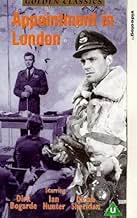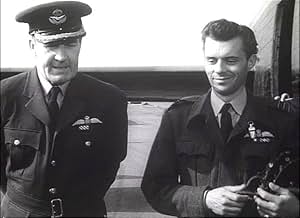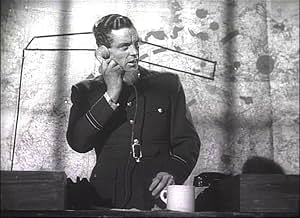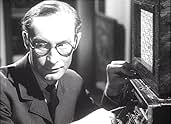Füge eine Handlung in deiner Sprache hinzuWar drama about the dangerous and stressful work of Lancaster bomber British crews during World War II.War drama about the dangerous and stressful work of Lancaster bomber British crews during World War II.War drama about the dangerous and stressful work of Lancaster bomber British crews during World War II.
Empfohlene Bewertungen
This is probably the most realistic drama filmed about Bomber Command late in WWII. The technical details are superb.. the right aircraft in the right locations with the correct props and background.
The acting really is first class and if it seems a little stilted then that's how it was then... if you don't believe me watch "Target for Tonight" which covered a Wellington Bomber mission early in the war and used real RAF crews .
There are no over the top heroics, but the mood is just right, with a constant tension even in moments of relaxation... the war had become a relentless exercise in mechanised killing with operational crews knowing that the chances of them living to complete a full tour of 30 operations was one in four at best, but they just got on with it. far better than "The Dam Busters".
The acting really is first class and if it seems a little stilted then that's how it was then... if you don't believe me watch "Target for Tonight" which covered a Wellington Bomber mission early in the war and used real RAF crews .
There are no over the top heroics, but the mood is just right, with a constant tension even in moments of relaxation... the war had become a relentless exercise in mechanised killing with operational crews knowing that the chances of them living to complete a full tour of 30 operations was one in four at best, but they just got on with it. far better than "The Dam Busters".
This is an unusual film. As others have commented it is well made, tautly scripted and has very good central performances. But that isn't what singles it out.
It's commonly thought that night time area bombing by the RAF was a hit or miss affair, quite different from daylight precision bombing done by the USAAF. Whilst no one can argue that targets were easier to see during daylight hours, both the RAF and the Luftwaffe developed highly accurate methods of hitting their targets at night. In the fateful Dresden raid in February 1945, almost 95% of the RAF bombload fell within one mile of the markers placed with 50 metre accuracy by the Mosquito target illuminator aircraft. The following day, a quarter of the American daylight force sent to follow up bombed Prague, having mistaken one bend in the River Elbe for another.
This film depicts, at length, the method of target marking the flight path using coloured airburst flares, eliminating 'creepback' by approaching the target along different vectors, air and ground marking the target and using a 'Master Bomber' to control the incoming streams and give bomb aimers feedback on accuracy.
No medal was struck for Bomber Command and many of the crew themselves felt their contribution was best forgotten, so this film is one of the few accurate testaments to their courage.
It's commonly thought that night time area bombing by the RAF was a hit or miss affair, quite different from daylight precision bombing done by the USAAF. Whilst no one can argue that targets were easier to see during daylight hours, both the RAF and the Luftwaffe developed highly accurate methods of hitting their targets at night. In the fateful Dresden raid in February 1945, almost 95% of the RAF bombload fell within one mile of the markers placed with 50 metre accuracy by the Mosquito target illuminator aircraft. The following day, a quarter of the American daylight force sent to follow up bombed Prague, having mistaken one bend in the River Elbe for another.
This film depicts, at length, the method of target marking the flight path using coloured airburst flares, eliminating 'creepback' by approaching the target along different vectors, air and ground marking the target and using a 'Master Bomber' to control the incoming streams and give bomb aimers feedback on accuracy.
No medal was struck for Bomber Command and many of the crew themselves felt their contribution was best forgotten, so this film is one of the few accurate testaments to their courage.
It has something of an inauspicious title, in that it doesn't do justice to the film making craft and subject matter on offer here in Phillip Leacock's film.
Leacock and his lead man, the splendidly regal Dirk Bogarde, produce a war film of undoubted human depth. There's no sledge hammer tactics to try and curry favour with the critics and film goers alike, no clichés bogging the narrative down, this is an honest to goodness telling of the emotional trials, strains, fears and peeves of a Bomber Command Squadron in England preparing for a mission during WWII 1943. Even the inevitable romantic threads are handled with skill by the makers, never cloying and adding impact as the heroes get ready for the big bully off.
Some of the action sequences show their age, but that's fine in the context of old time cinema, while the likes of Twelve O'Clock High (which came four years before this was released) set the bar too high for Leacock's film to be unfairly compared with. Yet this earns its stripes, very much so, because as those wonderful Avro Lancaster's take to the skies and thunder though the clouds, you realise you care about every single one of those involved in the mission, both in the air and on the ground. 7.5/10
Leacock and his lead man, the splendidly regal Dirk Bogarde, produce a war film of undoubted human depth. There's no sledge hammer tactics to try and curry favour with the critics and film goers alike, no clichés bogging the narrative down, this is an honest to goodness telling of the emotional trials, strains, fears and peeves of a Bomber Command Squadron in England preparing for a mission during WWII 1943. Even the inevitable romantic threads are handled with skill by the makers, never cloying and adding impact as the heroes get ready for the big bully off.
Some of the action sequences show their age, but that's fine in the context of old time cinema, while the likes of Twelve O'Clock High (which came four years before this was released) set the bar too high for Leacock's film to be unfairly compared with. Yet this earns its stripes, very much so, because as those wonderful Avro Lancaster's take to the skies and thunder though the clouds, you realise you care about every single one of those involved in the mission, both in the air and on the ground. 7.5/10
Some of the best war films have been movies about the Allied bombing campaign of WWII. "Command Decision", "12 O'Clock High" and "Raiders in the Sky" are all excellent films--though the latter is set at a British bomber base whereas the first two are about American bases. While I wouldn't quite put this film in the same level as the other two in quality, it is awfully close and well worth your time.
The film centers around Wing Commander Mason (Dirk Bogarde). He's a very good pilot. However, his 87 missions is wearing on him and he's long overdue to be retired from the front line. Oddly, instead of being happy about this, Mason insists on being able to at least reach 90...and then he'll quit. The film is a nice portrait of Lancaster pilots and crew and because it was made not too long after the war, the filmmakers were able to use three airworthy bombers--which added to the realism.
So why do I think this one isn't quite up to the level of the American films? Well, mostly because Mason just seems to take the whole thing in stride (apart from insomnia) and he seems amazingly well adjusted...taking away from the tension that DID come because the other two films focused so strongly on the emotional toll. Still, a nice tribute to these brave men and well worth your time.
The film centers around Wing Commander Mason (Dirk Bogarde). He's a very good pilot. However, his 87 missions is wearing on him and he's long overdue to be retired from the front line. Oddly, instead of being happy about this, Mason insists on being able to at least reach 90...and then he'll quit. The film is a nice portrait of Lancaster pilots and crew and because it was made not too long after the war, the filmmakers were able to use three airworthy bombers--which added to the realism.
So why do I think this one isn't quite up to the level of the American films? Well, mostly because Mason just seems to take the whole thing in stride (apart from insomnia) and he seems amazingly well adjusted...taking away from the tension that DID come because the other two films focused so strongly on the emotional toll. Still, a nice tribute to these brave men and well worth your time.
"Appointment in London" is an unusually-atmospheric, stylish and very-consistently-interesting late British WWII film. The subject is the pilots of British Bomber Command and the stresses they encounter in battles as the fly Lancasters in night missions over the European mainland. Specifically, the film features as its central character a dedicated pilot, played elegantly by Dirk Bogarde. He has completed 89 missions and survived, but very much wants his 90th. Due to fatigue and concerns for his well being, echelon grounds him. he is angry and frustrated, but during his time on the ground, he reconnects to life and wins lovely Dinah Sheridan, who acts very strongly as the widow of a naval intelligence type, winning her from breezy Willaim Sylvester, a U.S. pilot. The added tension in the film comes from Bogarde's desire to complete his third tour with one final mission, and the fact that everything about it sets up to be a "jinxed" mission from the start. I will not give away the breath-taking and vivid climax, but apart from some leisurely spots here and there, I will claim that director Philip Leacock has produced one of the best of all war films in "Appointment in London" The script was credited to Robert Westerby and John Woolridge, with cinematography by Stephen Dade and art direction by Donald M. Ashton. John Woolridge also wrote the fine original score, and costumes were contributed by Sheila Graham. In appearance, the film is very strongly made, and attractively photographed. The aerial sequences are very good and the recreated picture of wartime London is a big selling point for this hard-to-find film. Bogarde and Sheridan are extraordinarily touching and intelligent; I cannot recommend this film too highly as drama, as a war movie or as a cinematic "sleeper", one which in lesser hands would not have been as absorbing as it was made to be.
Wusstest du schon
- WissenswertesThis movie was filmed at R.A.F. Upwood. The Lancasters used were NX673, NX679, and NX782. These aircraft also took part in the filming of Mai 1943 - Die Zerstörung der Talsperren (1955).
- PatzerIn the scene depicting the take off starring Bill Kerr as the Australian pilot, he starts the aircraft up with the phrase "contact port outer". This is incorrect - the Lancaster would have started with the port inner engine as this drove the hydraulics which controlled the turrets etc.
- Crazy CreditsClosing credits epilogue: This story is humbly dedicated to all those airmen who were unable to keep an Appointment in London
- VerbindungenFeatured in Into the Wind (2011)
Top-Auswahl
Melde dich zum Bewerten an und greife auf die Watchlist für personalisierte Empfehlungen zu.
- How long is Raiders in the Sky?Powered by Alexa
Details
- Erscheinungsdatum
- Herkunftsland
- Sprachen
- Auch bekannt als
- Raiders in the Sky
- Drehorte
- Produktionsfirma
- Weitere beteiligte Unternehmen bei IMDbPro anzeigen
- Laufzeit1 Stunde 36 Minuten
- Farbe
- Seitenverhältnis
- 1.37 : 1
Zu dieser Seite beitragen
Bearbeitung vorschlagen oder fehlenden Inhalt hinzufügen

Oberste Lücke
By what name was Appointment in London (1953) officially released in India in English?
Antwort
































